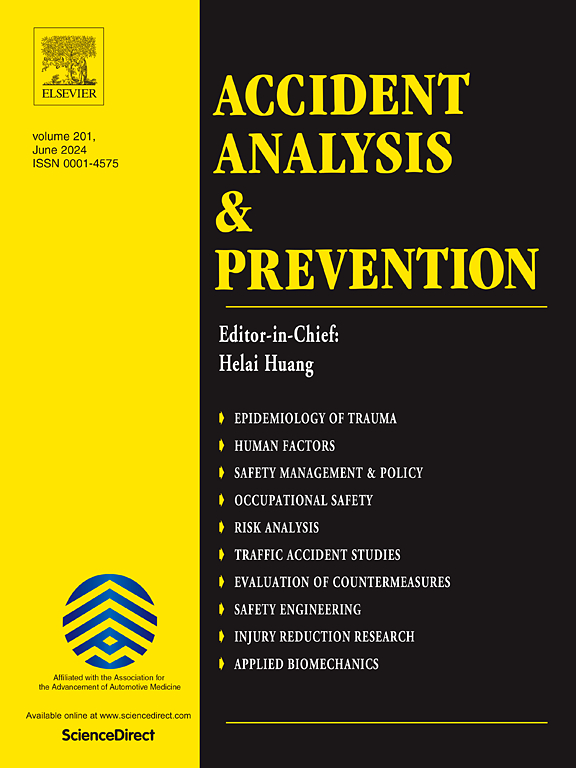Effectiveness of smart horizontal markings on drivers’ behavior along horizontal curves: A driving simulation study
IF 6.2
1区 工程技术
Q1 ERGONOMICS
引用次数: 0
Abstract
Photoluminescent road markings (PRMs) are a potentially useful visual guidance technology for improving road safety in low-visibility conditions. However, the effectiveness of PRMs requires further research. Moreover, road infrastructure regulations lack guidelines for PRMs design. Here, we aimed at determining the effects of different PRMs colors and widths on transversal and longitudinal driving behavioral indices. We conducted a simulation-based 3x2x2 within-subjects experiment (PRM: unlit vs. smart green vs. smart red; marking width: conventional vs. wide; curve direction: left vs. right). We designed six two-lane rural highway scenarios with nighttime light conditions and no traffic. Each scenario included twenty-four horizontal curves with radii ranging from 120 to 440 m (recommended speed range 60–90 km/h). Thirty participants (age range 20–54 years) drove a semi-dynamic driving simulator for about one hour. Our results showed that the presence of PRMs affected the drivers’ transversal behavior. The smart markings induced drivers to keep greater lateral distances from the road edge line than unlit ones along right curves. Smart green markings showed higher variability for vehicle positioning, indicating lower vehicle control. Wider-than-normal markings induced users to drive closer to the edge line at the Tangent-to-Spiral section. Overall, our study showed that smart markings - both green and red - induce the driver to “shy away” from the edge line, thus representing a potential tool for preventing roadway departure events. Further studies are expected to confirm these results by focusing on different PRM layouts, traffic, and weather conditions.
智能水平标线对驾驶员水平弯道行为的影响:驾驶仿真研究
光致发光道路标记(PRMs)是一种潜在的有用的视觉引导技术,可改善低能见度条件下的道路安全。然而,PRMs的有效性需要进一步研究。此外,道路基础设施法规缺乏关于预预管理系统设计的指导方针。在这里,我们旨在确定不同的PRMs颜色和宽度对横向和纵向驾驶行为指标的影响。我们进行了基于模拟的3x2x2受试者内实验(PRM:未照明vs.智能绿色vs.智能红色;打标宽度:常规vs宽;曲线方向:左vs右)。我们设计了六个两车道的乡村公路场景,在夜间灯光条件下,没有交通。每个场景包括24条半径为120至440米的水平弯道(建议速度范围为60-90公里/小时)。30名参与者(年龄在20-54岁之间)驾驶半动态驾驶模拟器约1小时。我们的研究结果表明,PRMs的存在影响了驾驶员的横向行为。智能标志诱导驾驶员在右侧弯道上与道路边缘保持更大的横向距离。智能绿色标记显示车辆定位的可变性较大,表明车辆控制较低。较宽的标记诱导用户在切线到螺旋段的边缘线附近驾驶。总的来说,我们的研究表明,智能标志——无论是绿色还是红色——都会诱导驾驶员“避开”边缘线,因此代表了防止道路偏离事件的潜在工具。进一步的研究预计将通过关注不同的PRM布局、交通和天气条件来证实这些结果。
本文章由计算机程序翻译,如有差异,请以英文原文为准。
求助全文
约1分钟内获得全文
求助全文
来源期刊

Accident; analysis and prevention
Multiple-
CiteScore
11.90
自引率
16.90%
发文量
264
审稿时长
48 days
期刊介绍:
Accident Analysis & Prevention provides wide coverage of the general areas relating to accidental injury and damage, including the pre-injury and immediate post-injury phases. Published papers deal with medical, legal, economic, educational, behavioral, theoretical or empirical aspects of transportation accidents, as well as with accidents at other sites. Selected topics within the scope of the Journal may include: studies of human, environmental and vehicular factors influencing the occurrence, type and severity of accidents and injury; the design, implementation and evaluation of countermeasures; biomechanics of impact and human tolerance limits to injury; modelling and statistical analysis of accident data; policy, planning and decision-making in safety.
 求助内容:
求助内容: 应助结果提醒方式:
应助结果提醒方式:


